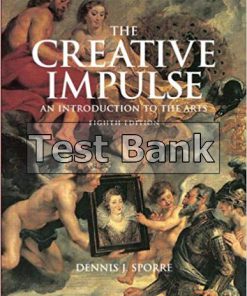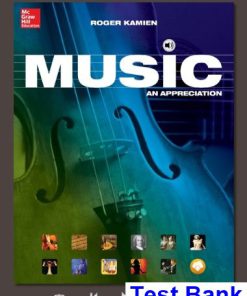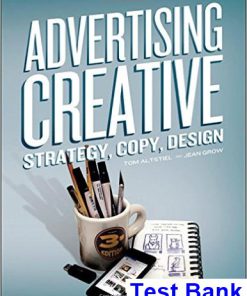Creative Approach to Music Fundamentals 11th Edition William Duckworth Test Bank
$26.50$50.00 (-47%)
Creative Approach to Music Fundamentals 11th Edition William Duckworth Test Bank.
You may also like
-
$26.50
$50.00
This is completed downloadable of Creative Approach to Music Fundamentals 11th Edition William Duckworth Test Bank

Product Details:
- ISBN-10 : 0840029985
- ISBN-13 : 978-0840029980
- Author: William Duckworth
A CREATIVE APPROACH TO MUSIC FUNDAMENTALS is a reader-friendly, creative text that focuses on music fundamentals through written and aural exercises. In addition, the text strives to teach students how to create music through learning rhythm, melody, scales, intervals, and triads.
Table of Content:
- Ch 1: The Basics of Music
- Introduction
- Rhythm
- Pulse
- Meter
- Measures
- Note Values
- Rests
- Pitch
- Clefs
- The Great Staff
- A Final Note
- Practice
- Ch 2: The Keyboard
- Introduction
- The White Keys
- The Black Keys
- Musical Distances
- Accidentals
- A Final Note
- Practice
- Focus on Skills 1: The Basics
- Ch 3: Rhythm I: Simple Meter
- Introduction
- Dotted Notes
- Time Signatures
- Simple Meter
- A Counting Method for Simple Meters
- Conducting Simple Meters
- Beams in Simple Meter
- Tempo
- A Final Note
- Practice
- Ch 4: Rhythm II: Compound Meter
- Introduction
- Compound Meter
- A Counting Method for Compound Meters
- Beams in Compound Meter
- Conducting Compound Meters
- Ties
- Repeat Signs
- Triplets and Duplets
- A Counting Method for Triplets and Duplets
- A Final Note
- Practice
- Focus on Skills 2: Rhythm
- Ch 5: Pitch
- Introduction
- Enharmonic Pitches
- Ledger Lines
- The Octave Sign
- Octave Identification
- Dynamics
- How to Read a Musical Map
- A Final Note
- Practice
- Focus on Skills 3: Pitch
- Ch 6: Major Scales
- Introduction
- Scales as Interval Patterns
- Elements of the Major Scale
- Naming Scale Degrees
- Ear Training
- A Final Note
- Practice
- Ch 7: Major Key Signatures
- Introduction
- The Key Signature
- The Circle of Fifths: Major Keys
- A Final Note
- Practice
- Focus on Skills 4: Scales 1
- Ch 8: Intervals
- Introduction
- Interval Identification
- Perfect Intervals
- Major and Minor Intervals
- Compound Intervals
- Harmonic Inversion of Intervals
- A Final Note
- Practice
- Focus on Skills 5: Intervals
- Ch 9: Minor Key Signatures
- Introduction
- Related Keys
- Minor Key Signatures
- Parallel Keys
- The Circle of Fifths: Minor Keys
- A Final Note
- Practice
- Ch 10: Minor Scales
- Introduction
- Natural Minor Scale
- Harmonic Minor Scale
- Melodic Minor Scale
- Minor Scales in Actual Music
- How to Sing Minor Scales
- A Final Note
- Practice
- Ch 11: Pentatonic and Blues Scales
- Introduction
- The Pentatonic Scale
- The Blues Scale
- A Final Note
- Practice
- Focus on Skills 6: Scales 2
- Ch 12: Triads
- Introduction
- Basic Structure of Triads
- Major and Minor Triads
- Close and Open Positions
- Augmented and Diminished Triads
- Triads and Scales
- Inversions of Triads
- Labeling Inversions
- A Final Note
- Practice
- Ch 13: Triads in a Musical Context
- Introduction
- Three Ways to Label Triads
- Seventh Chords
- Recognizing Triads in Actual Music
- A Final Note
- Practice
- Ch 14: Chord Progressions
- Introduction
- The Dominant/Tonic Relationship
- Cadences
- Simple Chord Progressions
- A Final Note
- Practice
- Focus on Skills 7: Triads and Progressions
- Ch 15: Writing a Song
- Introduction
- Primary and Secondary Chords
- Harmonizing a Melody
- Tips for Harmonizing
- Musical Form
- A Final Note
- Practice
- Appendix A: Graded Rhythms for Counting and Performing
- Simple Meters
- Compound Meters
- Less-Familiar Meters (Simple and Compound)
- Appendix B: Graded World Rhythms in Two and Three Parts
- Two-Part Rhythms
- Three-Part Rhythms
- Appendix C: Syllables for Sight Singing Scales and Modes
- Appendix D: Graded Melodies for Sight Singing and Playing
- Major Keys
- Minor Keys
- Appendix E: Chromatic Scale and Major Scale Fingerings for Keyboard Instruments
- Chromatic Scale
- Major Scales
- Appendix F: The C Clef
- Appendix G: Other Scales and Modes
- Modes
- Transposing the Modes
- The Whole-Tone Scale
- The Octatonic Scale
- Appendix H: Transposing the Modes
- Appendix I: A Brief Introduction to Timbre
- Appendix J: A Brief Discussion of Acoustics
- Frequency
- Amplitude
- Duration
- Timbre
- Appendix K: Basic Guitar Chords
- Major Keys
- Minor Keys
- Glossary
- Subject Index
- Index to Musical Examples
People Also Search:
creative approach to music fundamentals
creative approach to music fundamentals 11th edition william duckworth
creative approach to music fundamentals 11th edition
creative approach to music fundamentals 11th edition testbank download pdf
creative approach to music fundamentals 11th edition download scribd












